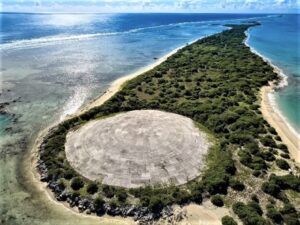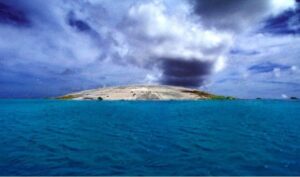U.S. Pacific Proving Grounds + Pacific Islanders
Social Responsibility requires an attempt to improve options and outcomes for those forced to mange the unintended healthcare and genetic consequences in mankind’s global the advancing atomic age.
Indigenous people were relocated in the Pacific Proving Grounds (PPG) with purpose and promises. Their plight is the subject of global concern and their land now houses a radioactive dome that contaminated yet another generation of veterans sent to clean up and try to contain the radioactive debris with a 20 year solution to a 250,000 year problem.
Joint Task Forces (JTF) Atomic Testing in the Pacific. Various countries used locations in the Pacific Ocean for Hydrogen and nuclear weapons testing. Some JTFs involved not just multiple branches of the service, but cooperation of two or more nations, in the case of the Christmas Island tests, it involved the U.K., Australia and U.S.A.
 43 nuclear tests were fired at Enewetak from 1948 to 1958. After the end of World War II and Japan’s surrender, Enewetak came under the control of the United States as part of the Trust Territory of the Pacific Islands until the independence of the Marshall Islands in 1986.
43 nuclear tests were fired at Enewetak from 1948 to 1958. After the end of World War II and Japan’s surrender, Enewetak came under the control of the United States as part of the Trust Territory of the Pacific Islands until the independence of the Marshall Islands in 1986.
During its tenure, the United States evacuated the local residents many times, often involuntarily. The atoll was used for nuclear testing as part of the Pacific Proving Grounds. Before testing commenced, the U.S. exhumed the bodies of United States servicemen killed in the Battle of Enewetak and returned them to the United States to be re-buried by their families.
 Enewetak Atoll Atomic Cleanup Veterans. 4,000+ combined crews of military and civilian contractors were tasked to collect, bury and seal massive tons of radioactive debris and equipment in a concrete dome, clearly at risk for two reasons. It was only designed to be a 20 year lifespan solution that is clearly deteriorating, while rising oceans threaten to submerge it completely.
Enewetak Atoll Atomic Cleanup Veterans. 4,000+ combined crews of military and civilian contractors were tasked to collect, bury and seal massive tons of radioactive debris and equipment in a concrete dome, clearly at risk for two reasons. It was only designed to be a 20 year lifespan solution that is clearly deteriorating, while rising oceans threaten to submerge it completely.
Civilian Exposures. From local and regional fishermen to AEC and DOD civilian contractors, many were impacted genetically by unintended exposures and others were participants, aware or not, in Human Radiologic Experiments (HRE’s).
The Marshallese and their descendants homeland is inhabitable. Like those exposed in various locations and different industries, they continue to pass down genetic mutations and 60+ years later, yet still struggle to get recognition and resources.